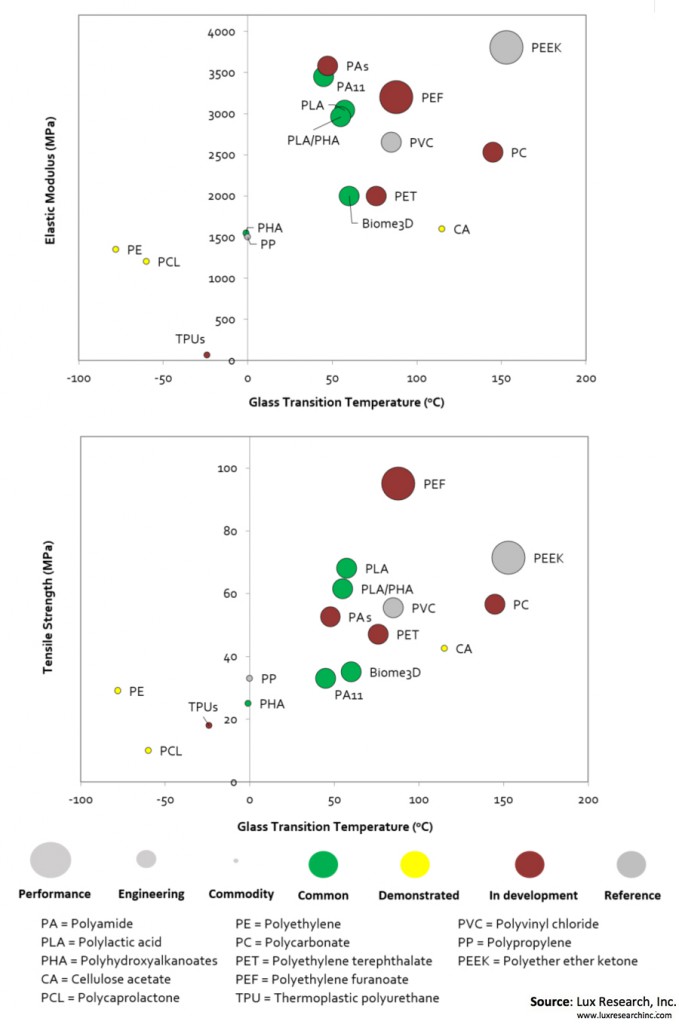3D printing has encouraged printable thermoplastic materials development and facilitated their application in functional prototyping, molds and tooling, and final part production. Only a small subset of these materials come from biological sources, making the production and disposal of 3D printed parts just as concerning for consumers and environmentally conscious businesses as in conventional manufacturing. New biopolymers currently in development for conventional manufacturing can provide interesting opportunities for expanding biopolymer use in 3D printing applications.
To determine the current state of bio-based 3D printable materials, available bio-based thermoplastics were cross-examined with currently 3D printable thermoplastics. The figure below shows this landscape as a function of glass transition temperature and a representative mechanical property. The development stage for various bio-based thermoplastics is identified by color, with commercially available 3D printable biopolymers in green, biopolymers that have been successfully printed in a noncommercial setting in yellow, and those still in development for traditional manufacturing in red. Based on thermal and mechanical properties, these polymers are also categorized as commodity, engineering, or performance thermoplastics with increasing circle diameter. Gray-colored materials are standard commodity, engineering, and performance-grade polymers (not biopolymers) for reference.

While currently available biopolymers demonstrate reasonable mechanical qualities in terms of both tensile strength and elastic modulus, their stable temperature range is limited and few biopolymers available today have moderately high operating temperatures. Developing bioplastics with enhanced thermal stability would greatly broaden the applications in which 3D printed bioplastics can be used, such as customizable consumer goods and automotive interior parts, and could lead to market growth for these materials.
For applications in which mechanical performance is important, polyethylene furanoate (PEF) shows the most promise for its chemical similarity to the commonly printed polyethylene terephthalate (PET) and its enhanced thermal and mechanical properties over current biopolymers. For applications in which temperature stability is the key metric, Mitsubishi Chemical Company’s Durabio polycarbonate (PC) stands out as a suitable starting point among bio-based engineering thermoplastics.
When selecting from available 3D printable materials, the method by which the material can be printed must be taken into consideration. The two most common methods for printing thermoplastic materials are fused filament fabrication (FFF) and selective laser sintering (SLS). Many more materials have been found to be compatible with FFF printing methods, however the quality of parts is markedly better for SLS printed materials. This presents an opportunity to further develop polyamides (PAs) from biological sources since the properties of these PAs can vary greatly and they are the most commonly used materials for SLS printing.
FFF serves as a good platform for testing new biopolymers given the flexibility of filament or pellet form factors and the broader adoption of FFF printers. FFF does, however, present higher barriers to adoption for new biopolymers in engineering and performance applications due to isotropic strength limitations among other drawbacks. In comparison, developing materials for SLS is more challenging due to the powder form factor required but offers more promise given the more production-oriented nature of SLS systems and an opportunity to expand the limited selection of materials currently available.
For chemicals and materials developers, the opportunity for bio-based 3D printable is for engineering grade polymers, particularly for use in consumer products that benefit from customization but are limited by the thermal stability of existing biopolymers. PEF and PC specifically show promise in expanding the current biopolymer use in 3D printing, with PEF and PC currently targeted at consumer products, and PC additionally for cosmetic automotive components.
Author
Olivia Hentz, Dayton Horvath
Source
Lux Research Blog, press release, 2017-07-14.
Supplier
Lux Research, Inc.
Mitsubishi Chemical
Share
Renewable Carbon News – Daily Newsletter
Subscribe to our daily email newsletter – the world's leading newsletter on renewable materials and chemicals









